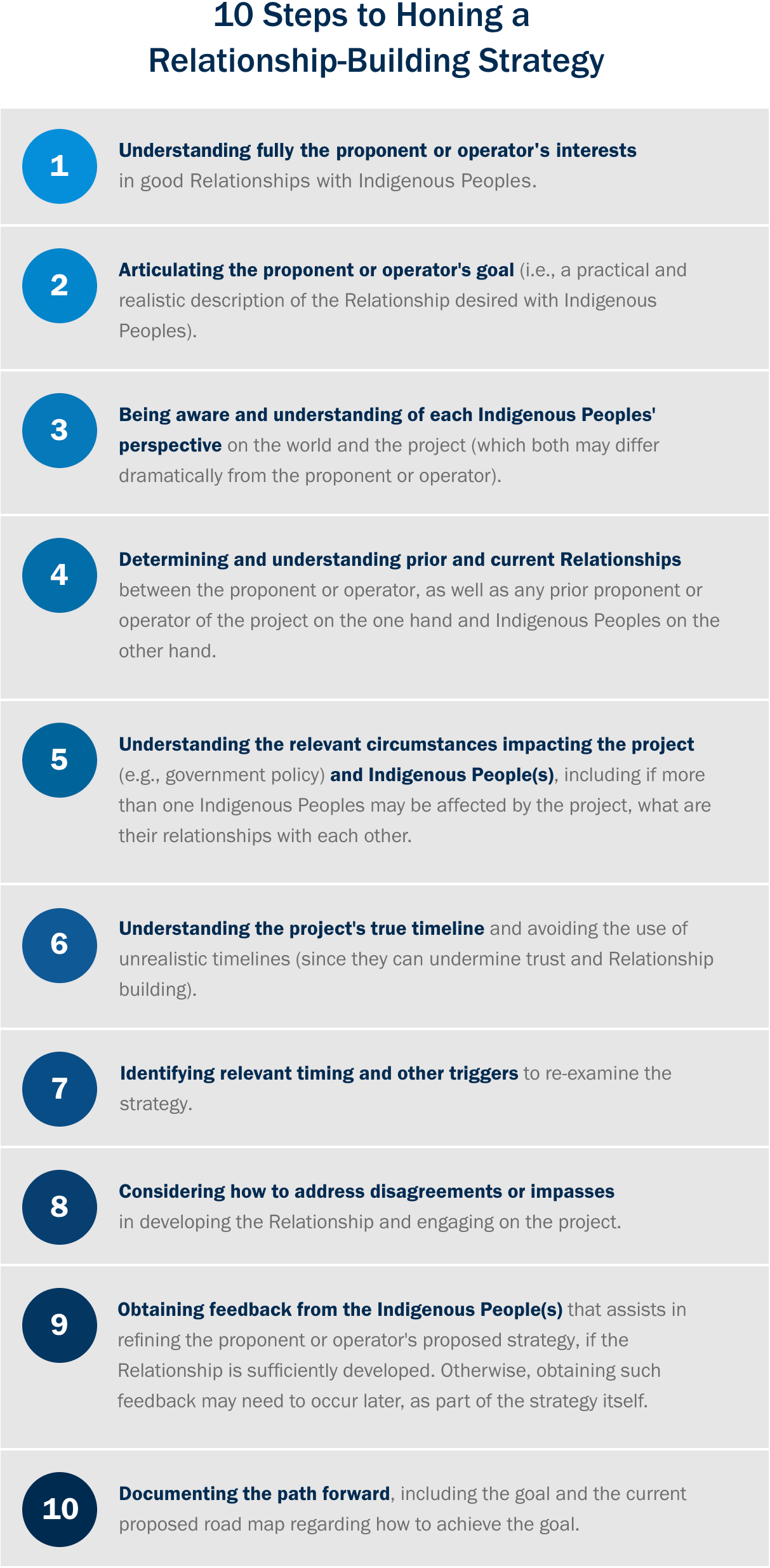With the start of a new year, many proponents and operators are taking stock of their project’s status, its path forward and its future milestones.1 An aspect of such evaluations that sometimes does not receive optimal focus is the relationship with any Indigenous people that may be affected by the project (Indigenous Peoples). Such relationships may provide a project with a number of benefits, including a competitive advantage.
While a project may benefit from any relationship building with Indigenous Peoples, this article focuses on developing and maintaining a particular type of relationship that we have seen repeatedly benefit large energy, infrastructure and mining projects. More specifically, these relationships generally have the following key attributes:
- The relationships are based on mutual respect and trust, the importance of which cannot be overstated. Mutual respect and trust built on positive, ongoing and mutual conduct.
- Each party understands the other’s interests over the short, medium and long term and is willing to accommodate, at least, some of the other party’s interests.
- The parties are committed to a long-term relationship (as opposed to a transactional or short-term approach). Part of this commitment is often due to aligning long-term interests, including financial ones.
In our experience, there is no “cookie cutter” process that leads to a strong, mutually-beneficial relationship with Indigenous Peoples (Relationship). However, the attributes described above are key indicia of such a Relationship.
Importance of Strong Relationships
A project proponent or operator with a good Relationship with Indigenous Peoples can benefit greatly at virtually every stage of the project, from its beginning to the project’s end. For example, such a Relationship may facilitate the permitting of a project, because among other things:
- the Indigenous Peoples typically are informed about and understands the project;
- the Indigenous People’s interests are understood by the proponent, which can assist in informing the government of these interests to facilitate the consultation process; and
- any accommodation is often already satisfactory to the Indigenous Peoples and the proponent, which greatly facilitates the accommodation process.
This is not to suggest that consultation and, if appropriate, accommodation are not necessary—rather, from the perspective of a proponent, the consultation and accommodation process is quicker and with less risk owing to the proponent’s Relationships with Indigenous Peoples.
In addition, in the political environment in a number of Canadian jurisdictions—where governments support one particular project, but not a similar project—strong Relationships with Indigenous Peoples can provide a project with a competitive advantage, which may ultimately affect the project’s practical viability.
Developing and Maintaining the Relationships
Like any relationship, developing and maintaining the Relationships with Indigenous Peoples takes sustained commitment. Developing such Relationships requires time for the demonstration of respect in both words and deeds to take root – and grow and evolve into trust. Likewise, the development of a robust understanding of other party’s interests and a commitment to a long-term relationship takes time. Depending on a particular Indigenous People’s governance structure, such people’s representatives may require community or other input prior to making decisions, which again may take time.
The development and maintenance of the Relationship can be complicated and typically requires careful management.
Further, maintaining Relationships with Indigenous Peoples takes continued effort. The demonstration of respect must continue and the established trust must be nurtured over time. Changing interests of the parties—including due to unexpected future circumstances impacting the project or changes in the leadership of Indigenous Peoples—must be communicated, understood and, if necessary, reflected in the relevant arrangements and future actions appropriately.
In short, the development and maintenance of the Relationship can be complicated and typically requires careful management. However, as described briefly above, the benefits of the Relationship to a project proponent or operator can be invaluable.
Benefits of a Strategy
In practice, a documented strategy—especially one that specifies its guiding principles—can be quite helpful in developing and maintaining Relationships with Indigenous Peoples. The exercise of articulating precisely and documenting a strategy (with its guiding principles) may result in a deeper level of thought and analysis than would otherwise occur. Moreover, a documented strategy and its guiding principles can be used to inform everyone working on behalf of the project proponent or operator—from employees, advisors and contractors—of the proponent or operator’s strategy and the importance of following it.
A documented strategy provides a mechanism to reduce the risk that new employees unknowingly act in a way that undermines the respect and trust developed.
People understanding and acting in accordance with the strategy is not merely an administrative exercise—rather, it can be critical to developing and maintaining a respectful and trusting relationship (since, for example, disrespectful and/or inconsistent conduct can quickly undermine trust).
The documented strategy also provides a mechanism to reduce the risk that new employees, advisors or contractors unknowingly act in a way that undermines the respect and trust previously developed. An additional side benefit of a documented strategy is that it helps new employees and others understand quickly and efficiently the proponent or operator’s strategy.
Time and other triggers for updating the documented strategy provide important check-in points for the proponent or operator to ensure that Relationships with Indigenous Peoples remain a focus over the project’s life.

While the optimal strategy for each project will vary based on the circumstances, undertaking the above steps will facilitate developing or updating a strategy that promotes strong, positive Relationships with Indigenous Peoples.
Conclusion
A project at any phase can benefit from good relationships with Indigenous Peoples, especially the Relationship model (described above). Developing and maintaining such Relationships (or for that matter, any good relationship with Indigenous peoples regarding a project) requires investing time, effort and resources. However, not all efforts to develop or maintain relationships with Indigenous Peoples are successful. For a number of reasons (including those mentioned above), a documented strategy to develop or maintain a strong Relationship with Indigenous Peoples can be invaluable to a project proponent or operator.
_________________________
1 While this article focuses on projects, most of the insights apply equally to many other significant undertakings that may affect the rights and title of Indigenous peoples.
Subscribe and stay informed
Stay in the know. Get the latest commentary, updates and insights for business from Torys.
Stay in the know. Get the latest commentary, updates and insights for business from Torys.
Subscribe Now



